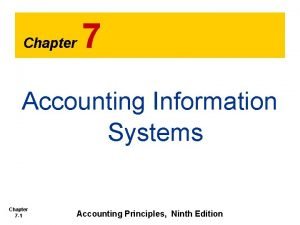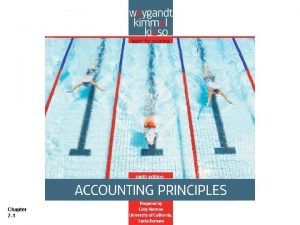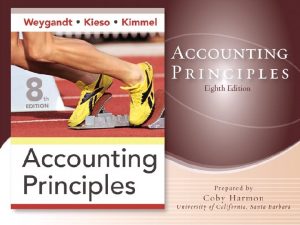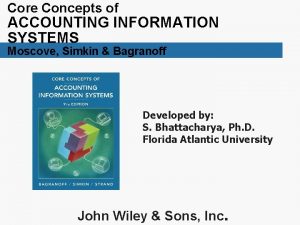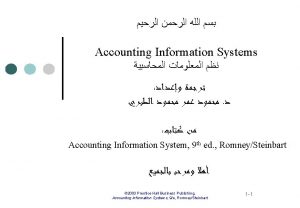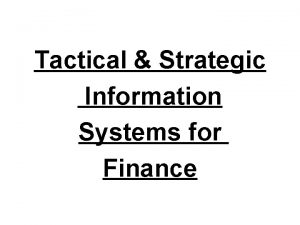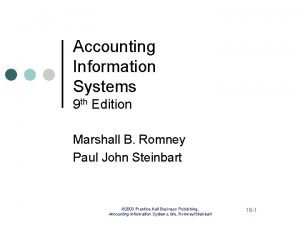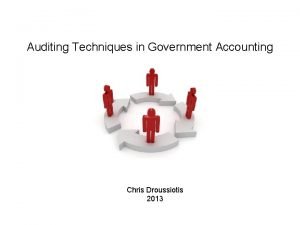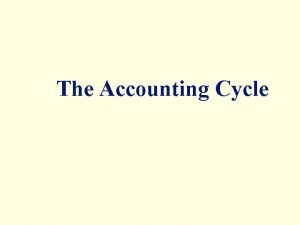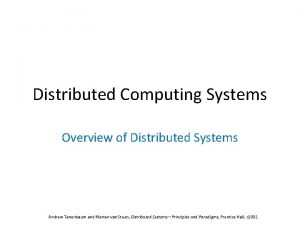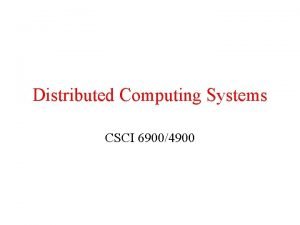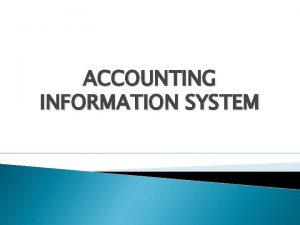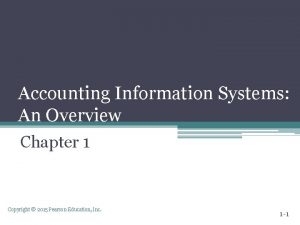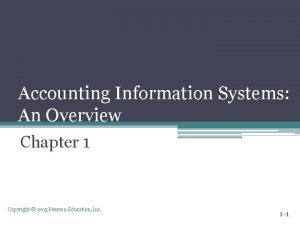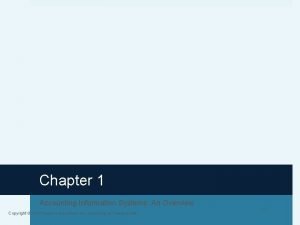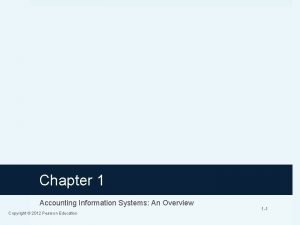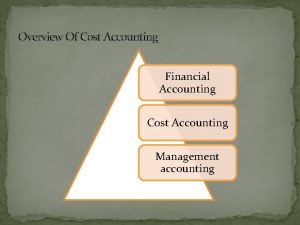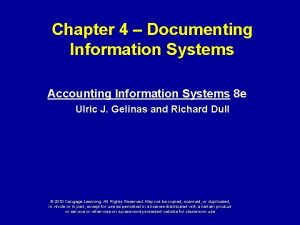Accounting Information Systems An Overview Chapter 1 Copyright














- Slides: 14

Accounting Information Systems: An Overview Chapter 1 Copyright © 2015 Pearson Education, Inc. 1 -1

Learning Objectives • Distinguish between data and information: ▫ Understand the characteristics of useful information. ▫ Explain how to determine the value of information. • Describe the major business processes present in most companies. • Explain what an accounting information system (AIS) is and describe its basic functions. Copyright © 2015 Pearson Education, Inc. 1 -2

Systems, Data, and Information • A system is a set of two or more interrelated components that interact to achieve a goal. • Systems are almost always composed of smaller subsystems, each performing a specific function supportive of the larger system. Copyright © 2015 Pearson Education, Inc.

Data vs. Information • Data are facts stored in the system ▫ A fact could be a number, date, name, and so on. For example: 2/22/14 ABC Company, 123, 99, 3, 20, 60 Copyright © 2015 Pearson Education, Inc. 1 -4

Data vs. Information The previous slide just showed facts, if we put those facts within a context of a sales invoice, for example, it is meaningful and considered information. Invoice Date : 2/22/14 Invoice #: 123 Customer: ABC company Item # 99 Qty 3 Total Invoice Amount Copyright © 2015 Pearson Education, Inc. Price $20 $60 1 -5

Systems, Data, and Information • Usually, more information and better information translates into better decisions. • However, when you get more information than you can effectively assimilate, you suffer from information overload. • When you’ve reached the overload point, the quality of decisions declines while the costs of producing the information increases. Copyright © 2015 Pearson Education, Inc.

Value of Information • Information is valuable when the benefits exceed the costs of gathering, maintaining, and storing the data. Benefit (i. e. , improved decision making) > Cost (i. e. , time and resources used to get the information) Copyright © 2015 Pearson Education, Inc. 1 -7

What Makes Information Useful? There are seven general characteristics that make information useful: 1. Relevant: information needed to make a decision (e. g. , the decision to extend customer credit would need relevant information on customer balance from an A/R aging report) 2. Reliable: information free from error and bias 3. Complete: does not omit important aspects of events or activities 4. Timely: information needs to be provided in time to make the decision Copyright © 2015 Pearson Education, Inc. 1 -8

What Makes Information Useful? 5. Understandable: information must be presented in a meaningful manner 6. Verifiable: two independent people can produce the same conclusion 7. Accessible: available when needed Copyright © 2015 Pearson Education, Inc. 1 -9

Transactional Information Between Internal and External Parties in an AIS • Business organizations conduct business transactions between internal and external stakeholders. • Internal stakeholders are employees in the organization (e. g. , employees and managers). • External stakeholders are trading partners such as customers and vendors as well as other external organizations such as Banks and Government. • The AIS captures the flow of information between these users for the various business transactions. Copyright © 2015 Pearson Education, Inc. 1 -10

Interactions Between AIS and Internal and External Parties Copyright © 2015 Pearson Education, Inc. 1 -11

Basic Business Processes • Transactions between the business organization and external parties fundamentally involve a “give–get” exchange. These basic business processes are: ▫ Revenue: give goods/service—get cash ▫ Expenditure: get goods/service—give cash ▫ Production: give labor and give raw materials—get finished goods ▫ Payroll: give cash—get labor ▫ Financing: give cash—get cash Copyright © 2015 Pearson Education, Inc. 1 -12

What Is an Accounting Information System? • It can be manual or computerized • Consists of ▫ People who use the system ▫ Processes ▫ Technology (data, software, and information technology) ▫ Controls to safeguard information • Thus, transactional data is collected and stored into meaningful information from which business decisions are made and provides adequate controls to protect and secure the organizational data assets. Copyright © 2015 Pearson Education, Inc. 1 -13

The CITP Designation • CITP: Certified Information Technology Professional • Identifies CPAs who possess a broad range of technological knowledge and the manner in which information technology (IT) can be used to achieve business objectives • Reflects the AICPA’s recognition of the importance and interrelationship of IT with accounting Copyright © 2015 Pearson Education, Inc.
 Chapter 7 accounting information systems
Chapter 7 accounting information systems Chapter 7 accounting information systems
Chapter 7 accounting information systems Chapter 7 accounting information systems
Chapter 7 accounting information systems Accounting information system chapter 1
Accounting information system chapter 1 Core concepts of accounting information systems
Core concepts of accounting information systems Accounting information system شرح
Accounting information system شرح Tactical accounting
Tactical accounting Accounting information systems marshall b romney
Accounting information systems marshall b romney Computerized accounting software
Computerized accounting software Overview of government accounting
Overview of government accounting Process of accounting
Process of accounting Financial accounting and accounting standards chapter 1
Financial accounting and accounting standards chapter 1 Distributed systems overview
Distributed systems overview Sap project system overview
Sap project system overview Introduction to distributed computing
Introduction to distributed computing
